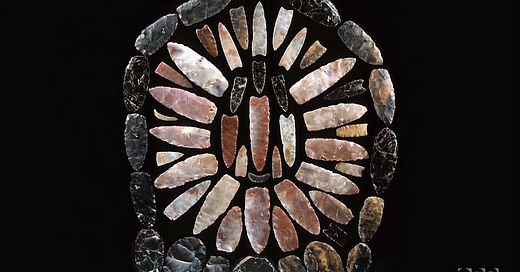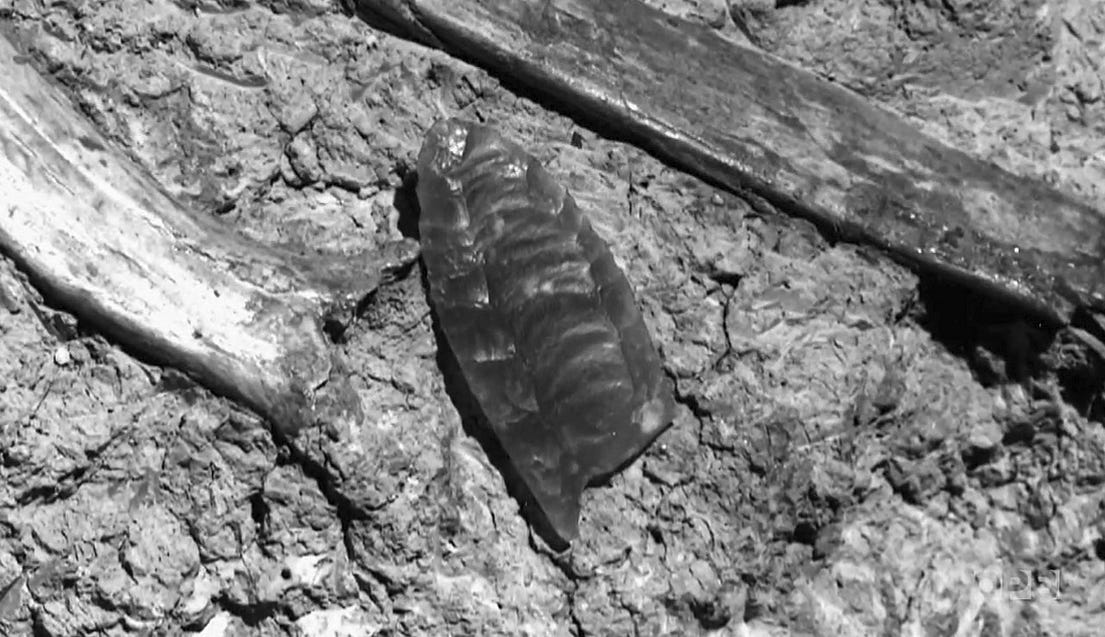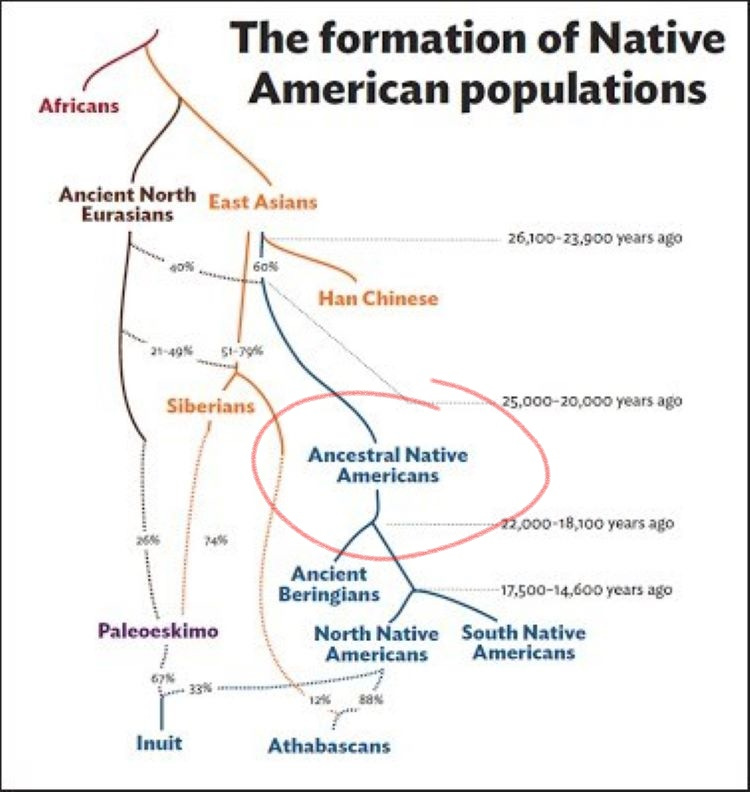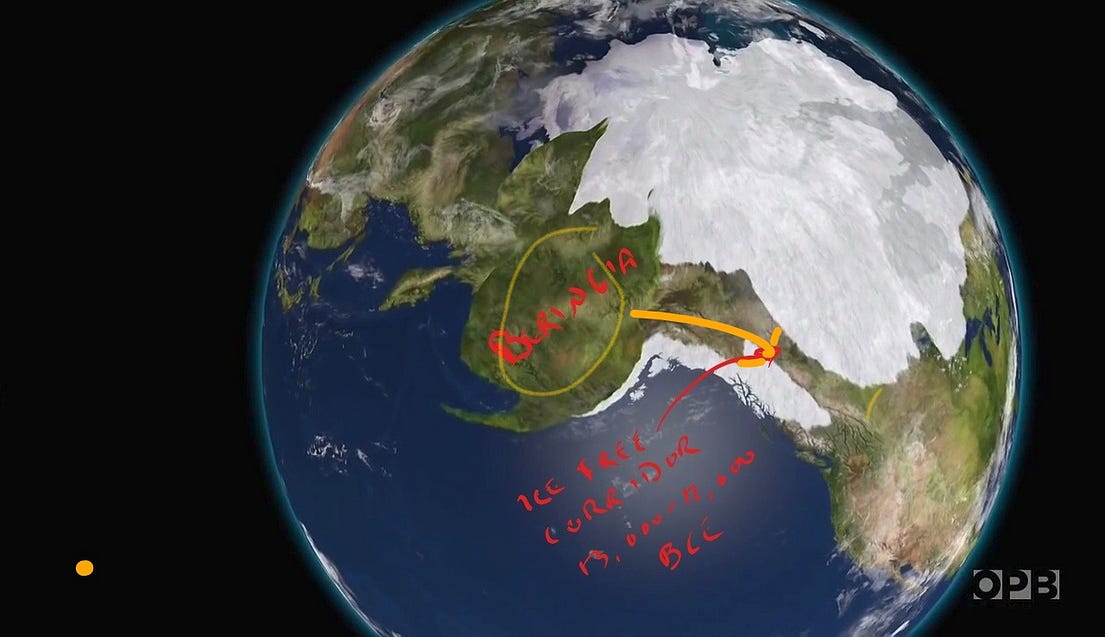The Crisis Report -29
Thinking about Culture and Information Transmission. Most of what you “know” is incorrect or outdated. That has implications.

I offer up the “Parable of Clovis Culture”.
These incredible points are what are known as “Clovis points”. They were found in the 60’s all together at a site in Montana known as the “Anzick site”.
The cache of points was part of a ritual deposit in the grave of an infant male who was buried around 11,000BCE. This makes the site unique and invaluable to archeologists who study how humans colonized the Americas during the last Ice Age.
Because, it is the only Clovis Culture human remains we have. The Anzick site is the only Clovis Culture burial ever found. This makes the remains of the infant priceless to paleo-geneticists because they are the only sample we have of Clovis Culture DNA.
Now, you are probably asking yourself, “what is the Clovis Culture and why should I care?”
My answer is threefold.
The Clovis people, a mysterious group, are supposed to be the “First Culture in America”. The first group to colonize the Americas from the Bering Land Bridge.
The evolution of the science around the Clovis Culture is a highly illuminating story about the Culture of Science.
The spread of the “Clovis Culture Meme” in popular culture is an important story about how information is transmitted and absorbed by the population. It makes clear why 80% of what you think you know at any given moment, is incorrect or outdated.
If that doesn’t engage your interest, well, then this article isn’t for you. You don’t have to read the rest. There won’t ever be a test on this later. Feel free to stop at any time, OK.
The Story of “Clovis Culture” and What it tells us about the Culture of Science.
If you are unfamiliar with the term Clovis Culture, it comes from a cluster of sites that were excavated in the 1930’s near the town of Clovis New Mexico. The archeologists had dug down to the lowest levels of occupation in a cave by recognizable indigenous cultures. On a whim, they decided to keep digging deeper.
At a much deeper level, they found artifacts. Artifacts from a time when everyone said there shouldn’t be any artifacts. Artifacts dating back to the end of the last Ice Age. A time when it was assumed the Americas were completely unpopulated.
The stone spear points, like the one shown in the picture above, had a very distinctive style, were associated with the bones of ice age fauna, and were clearly much older than any other artifacts that had been found up to this time.
Clovis points, as this style of projectile point came to be known, turned up everywhere in North America with a few even showing up in Central and South America. Until very recently, you could not date stone artifacts directly but radio carbon dates for bones and charcoal associated with Clovis points gave date ranges of around 11,200 BCE to 10,900 BCE for the earliest sites.
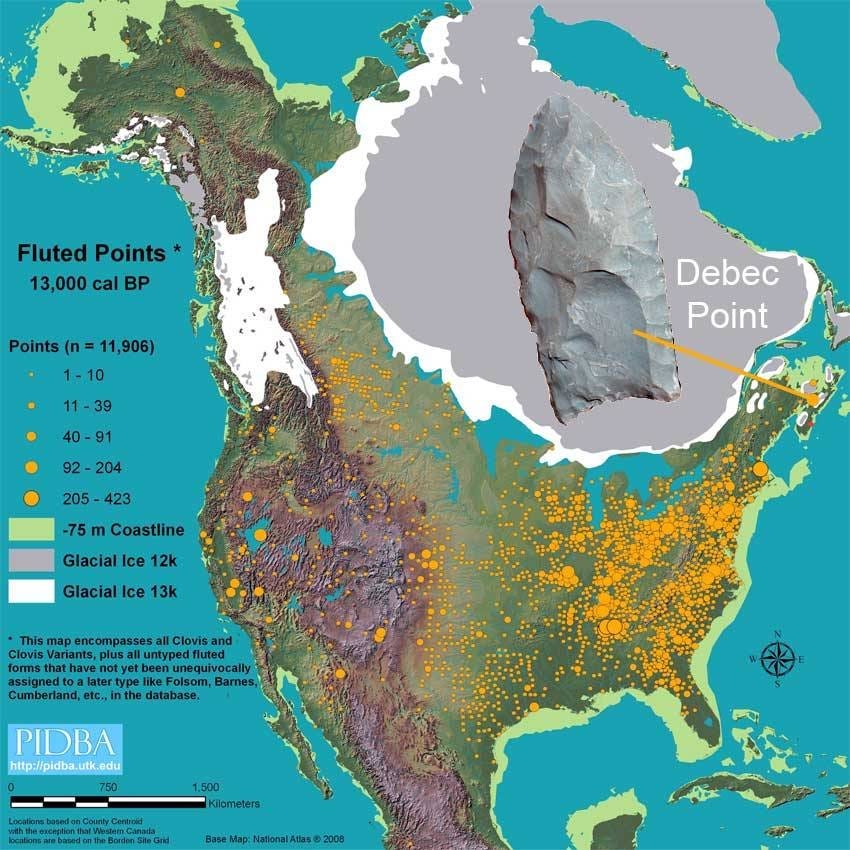
If you were sharp eyed, you probably noticed the gap in the glaciers on the map of Clovis point sites. After the discovery of Clovis points everywhere, this gap was proposed as the route that Paleoindians took from Beringia to move south into the new world.
This became the prevailing paradigm.

It became the story of the human migration starting out of Africa and ending in the New World. As you can see above, people pour through a gap between two ice age glaciers and then fan out across the continent. As it says in the voice over of this NOVA science documentary from about six years ago, “they explode across the continent and become Clovis, the first culture, the first people in America”.
If the viewer is not an archeology nerd they will be likely to think that this is “how it happened”. This is a good story, it’s presented with confidence in a clear, easy to follow, narrative by a trusted source (NOVA) so why shouldn’t you believe it?
The answer is, because it’s not the truth. Or at least, not all of the truth.
The “Ice Free Corridor — Clovis First” theory was a product of the mid-20th century when New World archeology was still in its infancy. It made sense of the data points that had been discovered using the dating technology available at that time.
Since then, many sites (shown above) have been discovered that have been conclusively dated as being older than Clovis Culture. The existence of these sites demolishes the theory of “Clovis First” and makes the “ice-free corridor only” migration theory much less likely.
If you go back and look at the map of Clovis point finds you can see that there are several dates on the glaciers; 13,000k and 12,000k (both are BCE). These are the dates when the glaciers retreated, and the corridor opened.
Now, look at the dates on the sites above. Many of them predate the formation of the corridor that the first peoples are supposed to have come through. Not by just a little, by a lot. By thousands of years. This information is not mentioned in the NOVA documentary show at all and its omission is really disheartening.
This argument between the “Clovis First” and the “New Evidence” camps of archeologists IS the debate over how the Americas were colonized and the timing of that colonization. People have literally come to blows in arguments at archeology conferences over this.
By presenting only one side of the argument without debate, NOVA is infecting another generation of viewers with a meme that is at best questionable and at worst untrue.
Here’s a different story from a different perspective.

Here’s the world 27,000 years ago at the height of the last Ice Age. What’s the big thing that leaps out at you?
You should be noticing Beringia, AKA “The Bering Land-bridge” of mid-century archeology. It doesn’t look like you thought it would, does it?
Everyone has heard the meme of the first people crossing over from Asia to the Americas on the “Bering Land Bridge” but the reality is much more complex. Far more than a narrow “bridge” Beringia was a vast area.
In fact, most of the time it probably looked like this.
We imagine Beringia as being a cold frigid place covered in snow, but most of the time it probably looked like this. One of the paradoxes of an ice age is that they are relatively dry.
So much of the world’s water is locked up in the vast glaciers that relatively little snow falls. Winters in Beringia would have been very cold, but they would not have been particularly snowy. Siberia is covered in vast forests now because it is so much wetter, not because it is so much warmer.
Looking at it circa 25,000 BCE, during the last Glacial Maximum, it is easy to see how people migrating north, up the coast of China, or east, across the plains of Siberia, might wind up here.
It was a vast expanse of rolling plains that had existed for a very long time. In 25,000BCE, Beringia had been around for about 45,000 years already.
People think of the Bering Land Bridge as existing for a few thousand years when the glaciers retreated but before sea level rose. Beringia has actually existed multiple times, emerging, then vanishing as sea levels rose and fell. Its latest incarnation started around 70,000 BCE and it persisted until 10,000 BCE.
During this time a vast, cold and dry “Mammoth steppe” stretched across Eurasia. From the arctic islands southwards to China, and from Spain eastwards across Eurasia and over the Bering land bridge into Alaska and the Yukon where it was blocked by the Wisconsin glaciation.
Beringia was actually warmer than Europe during the last Ice Age.
Beringia received more moisture and intermittent maritime cloud cover from the north Pacific Ocean than the rest of the Mammoth steppe, including the dry environments on either side of it. This moisture supported a shrub-tundra habitat that provided an ecological refugium for plants, animals, and people.
Beringia was not the “ass-end of no-where”. It was a huge, fairly pleasant place that people from across the Mammoth Steppe moved to because it was better than where they were.
They lived in Beringia long enough to become genetically distinct.
Around 30,000BCE the population in Beringia became genetically distinct. They became the “Ancestral Native Americans”.
Now, here’s where theories diverge.
The Clovis First Hypothesis
After the discovery of the first Clovis points in the 30’s, other archeologists dug down to the same levels and discovered Clovis points. They were everywhere.
All of these sites were dating around 11,500 BCE to 10,900 BCE for the earliest sites. A tight 600 year range. Suddenly, people switched from the Beringian style points found in Alaska, to this new style of points found across North America.

So, the “Clovis First Hypothesis” was created to explain all of these data points. It argued that the glaciers between Beringia and North America were impassable. So, people stayed in Beringia until around 17,000BCE-13,000BCE when warming global temperatures.
Opened up an “ice free” corridor that people could pour through.

Because Beringia was shrinking due to the rising sea levels, hordes of people moved south through this corridor. As they emerged from it, they fanned out across the continent and adopted a new life-way. One based on hunting the big game of the late Ice Age American Serengeti.
Which was probably why they completely abandoned the style of points they had used for over 20,000 years. Adopting a new style of lithics during the several thousand year period they were spreading out over North America.
Which made them the first colonists of the America’s and Clovis Culture the first Paleoindian culture of the America’s. Hence the name, “Clovis First Hypothesis”.
Now, New World archeology is not a very old field of study. It’s actually just over 100 years old. So in the 50’s, when the Clovis First Hypothesis was put forth, it was building on foundational digs and studies. It explained the existing data points, it was easily understandable, and it resonated with the public.
Clovis First became the paradigm in New World Archeology by the 60's.
It’s what was in my high school American History textbook. In the first chapter, which explained how the Indians got to America without boats.
The second chapter was all about Columbus, Cortes, and the Conquest of the Indians by the (obviously superior) Spanish. Followed by chapter three, the arrival of White people in New England and the “real” start of American History.
If you knew anything about the Clovis Culture it’s probably because you remembered them from a high school or college class. If you aren’t interested in New World archeology you don’t have any reason to know more.
So, most people are still thinking about the indigenous colonization of the Americas using a mental paradigm that dates back to the 50’s. Here’s the problem, it’s wrong.
The New Evidence Hypothesis
So, after Clovis First became the prevailing paradigm archeology continued to be done. In 1975 some archeologists discovered a site in Monteverde Chile. They claimed it predated Clovis and was 14,500 years old (FYI it is now dated to 18,500 years old).
Now, if you believe in the idealized version of “science” that they teach you in grade school and high school. You might think, “Wow, new evidence. I bet archeologists rushed down to Chile to see the site and everyone hailed its discovery”.
You would be wrong. Real science, the kind that flawed human beings practice, rarely works like that. Instead, things got all racist and ugly.
American and European archeologists, who dominated the field of New World archeology, declared the Monteverde Site a fraud or “flawed”. In many cases they made this judgement without ever looking at the data.
They had decided Clovis First was correct. Many of them had build careers on validating that hypothesis. Now they were being threatened and they did a very human thing. They became defensive.
This moment happens almost every time in EVERY FIELD of “Science”. That’s the point Kuhn is making. This is the “normal process” of scientific change and revolution.
The defenders of the existing paradigm almost always defend it by marginalizing and dismissing evidence which contradicts their narrative. They almost always trash the reputations and question the motives of those who present evidence contradictory to the paradigm their careers were built on.
They argued that Monteverde had to be incorrect because no other evidence supported it. Then, they trashed the reputations and careers of anyone who argued otherwise.
This went on for decades.
Until in 1997 a blue ribbon panel investigated and declared the work at Monteverde to be of the highest standards and the date for the site to be valid.
Now there are dozens of pre-Clovis sites in both North and South America.
It has become common to see articles like this.
Most archaeologists think the first Americans arrived by boat. Now, they’re beginning to prove it. — Archaeologists are hunting on islands and under the waves for traces of the ancient mariners who likely settled the Americas.
First people in the Americas came by sea, ancient tools unearthed by Idaho river suggest —16,000-year-old occupation predates possible land route into the continents.
Even the mammoth hunting idea is being scrapped.
Clovis hunters’ reputation as mammoth killers takes a hit — Tests of stone points show that early Americans may have been better scavengers than hunters of the giant beasts.
It turns out it would have been damn near impossible to kill a mammoth with stone points and spears.
This view of a mammoth’s skeleton shows ribs and other bones that sheltered internal organs. A view from the top, shows presumed average (red) and maximum (blue) penetration depths of Clovis points hurled at high speeds at a mammoth, based on experimental evidence, assuming the weapons passed through dense hair and a thick hide, and avoided bones.
EXPERIMENTAL EVIDENCE INDICATES KILLING A MAMMOTH WITH A STONE TIPPED SPEAR IS JUST ABOUT IMPOSSIBLE.
The whole idea that stone age people’s hunted mammoth’s is actually based on really flimsy evidence. It traces back to the first museum exhibit on stone age human fossils at the London Museum in Victorian England. An artist drew hunters engaged in combat with a mammoth and the public loved it.
That’s where that came from. It was based on nothing and yet it has influenced our perception of paleolithic Ice Age life for over 100 years.
That’s how science actually works.
It’s human. It’s political. It’s messy and often unfair. It’s a social process.
Exactly like Thomas Kuhn described in his book, The Structure of Scientific Revolutions.
In Conclusion
Kuhn argued that in science, paradigm shifts occur when the old narrative that explained observable reality gets replaced by a new one. One that does a better job and doesn’t have holes of “unexplainable” evidence.
Here’s the thing though. As you can see from this example, it can be a slow process. Literally taking a lifetime for an old paradigm to be replaced by a new one. This is true everywhere you look in scientific fields of study.
Remember “string theory” in physics?
That sucked up the time and attention of a whole generation of physicists. We are now 99% sure it was a dead end. It took decades for the paradigm to shift and the physics community to “move on”.
This is how science usually works.
Think about that, then consider how old the information is that most people are basing their understanding of Global Warming on. Think about that the next time a “Climate Optimist” tells you that “DOOMERS” are “as bad as Deniers”. We all need to better understand how SCIENCE actually works if we want to be able to interpret what the scientists are telling us.
That’s the moral of this story.
This is my analysis.
This is what I see.
This is my “Crisis Report”.
-rc 03272023
Hi, my name is Richard and I'm a Doomer.
Listening to me is actually worse for you than listening to a “Climate Change Denier”. Lots of people these days think this.
Why climate ‘doomers’ are replacing climate ‘deniers’ WAPO 03/24
How U.N. reports and confusing headlines created a generation of people who believe climate change can’t be stopped.
The doomers are wrong about humanity’s future — and its past - The necessity of progress. VOX 03/20
The biggest danger we face today, if we care about actually making the future a more perfect place, isn’t that industrial civilization will choke on its own exhaust or that democracy will crumble or that AI will rise up and overthrow us all.
It’s that we will cease believing in the one force that raised humanity out of tens of thousands of years of general misery: the very idea of progress.
Progress solves the problems we didn’t know were problems.
Against doomerism VOX 03/20
It’s boom times for doom times, but from artificial intelligence to climate change to food supplies, there’s plenty of reason to be optimistic that the future will be better — if we make it so.
We need the right kind of climate optimism - Climate pessimism dooms us to a terrible future. VOX 03/21
People might defend doomsday scenarios as the wake-up call that society needs. If they’re exaggerated, so what? They might be the crucial catalyst that gets us to act on climate change.
Setting aside the moral problem of stretching the truth, this claim is wrong.
Scaring people into action doesn’t work. That’s true not just for climate change, air pollution, and biodiversity loss, but for almost any issue we can think of. We need optimism to make progress.
“CLIMATE CHANGE WILL END THE WORLD BY 2100…”
Climate doomism doesn’t help much. In fact, it’s counterproductive.
Climate denial and climate doom are both extremes on the climate action spectrum. And they are both as dangerous.
Climatologist Michael E Mann: 'Good people fall victim to doomism. I do too sometimes' The Guardian 02/21
Doom-mongering has overtaken denial as a threat and as a tactic. Inactivists know that if people believe there is nothing you can do, they are led down a path of disengagement. They unwittingly do the bidding of fossil fuel interests by giving up.
What is so pernicious about this is that it seeks to weaponise environmental progressives who would otherwise be on the frontline demanding change. These are folk of good intentions and good will, but they become disillusioned or depressed and they fall into despair. But “too late” narratives are invariably based on a misunderstanding of science.
If the science objectively demonstrated it was too late to limit warming below catastrophic levels, that would be one thing and we scientists would be faithful to that. But science doesn’t say that.
So, the biggest problem that the World faces is DOOMERS like me shaking people's confidence in the bright future that will inevitably happen. If we all "believe in science" and have faith in human ingenuity.
I guess this means, that after a LIFETIME of study, research, and evangelizing on the dangers of Global Warming and the Climate Change it brings. I am now part of the PROBLEM.
Now that I know, I'm the PROBLEM. I guess for "the good of us all" I should just shut up and wait for the utopia that's coming.
Or, not.
Until, next time.

